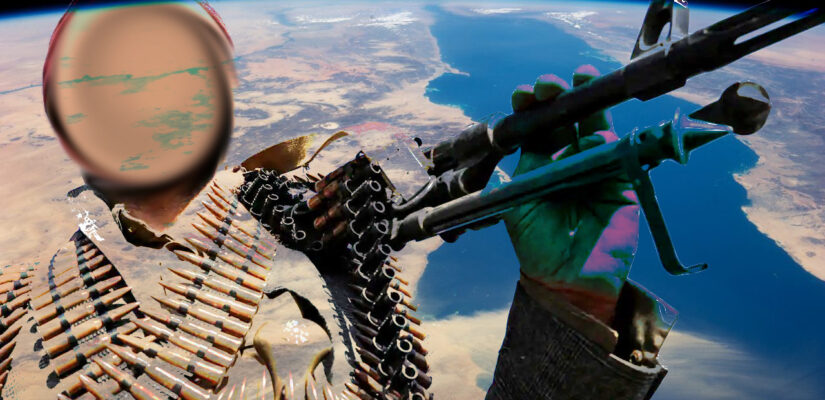
Vulnerable Depths: Securing Global Communications in the Wake of the Red Sea Undersea Cable Sabotage
JACOPO FRANCESCHINI
COMMENTARY #44 • FEBRUARY 2024
The strategic importance of the Red Sea for global politics and economy has become evident after the Houthis, a Yemeni armed group backed by Teheran, started targeting international vessels transiting in the Red Sea as a retaliation against Israeli military operations in the Gaza strip. As a result, security concerns over one of the most trafficked sea routes in the world have been impacting international trade. In particular, the international community’s reaction led to the creation of a US-led coalition to protect the navigation on the Red Sea, while the US and UK also conducted bombings in Yemen to weaken the Houthis military capacity and missile arsenal. The EU also launched a naval mission with military vessels of EU member states patrolling the Red Sea.
In parallel, the Houthis’ offensive capabilities have apparently expanded toward the disruption of international communication. According to the Israeli newspaper “Globe”, the Yemeni armed group damaged four submarine communication cables in the Red Sea, including AAE-1, Seacom, EIG, and TGN. These submarine cables are integral for connecting various continents, and their disruption could have potential effects of localized disruptions in the Gulf Area, India and Egypt. The official government of Yemen, recognized by the UN, warned at the beginning of February 2024 about the threat posed by the Houthis to vulnerable underwater communication in the Red Sea, which represents a passage point for almost 70% of intercontinental communication traffic. At the moment, the entity of the damages seems severe but not globally disruptive. While the Houthis officially denied any responsibility for the attack, this event allows some practical considerations on the role of undersea telecommunications in the global scenario and possible further steps to be taken at international level to protect and secure the infrastructure that underpins our modern digital world.
Indeed, beyond alleged responsibilities, this attack underlines a broader concern about the vulnerabilities of undersea cables, which, beyond their role in facilitating international communication and trade, have increasingly emerged as strategic assets in international politics and cybersecurity. Indeed, undersea cables, the backbone of global Internet connectivity, carry over 95% of international data, enabling everything from financial transactions to government communications and social media interactions. As such, what happened in the Red Sea is a stark reminder of the potential geopolitical leverage and disruption that can be achieved by targeting such infrastructure.
The significance of undersea cables transcends mere economic considerations, extending into the realm of national security and geopolitical strategy. Nations and non-state actors recognize these cables’ strategic value as tools for commerce, information, and overall stability. The alleged involvement of the Houthis amid ongoing regional tensions exemplifies how undersea cable infrastructure can become entangled in international conflicts, with the power to disrupt vital communications and exert pressure on adversaries – or even on the global community as a whole.
The repair and protection of these cables present complex challenges. The specialized nature of undersea cable repair, combined with security risks in the geopolitically tense regions at stake, highlights the need for robust international cooperation and the development of strategies to ensure the resilience of this critical infrastructure. Companies and consortia that own and operate these cables are now faced with the dual task of swiftly repairing damaged infrastructure and enhancing protective measures against future attacks while navigating the intricate web of international relations, security concerns and possible scenarios
This incident also brings to light the broader implications for cyber defense and the security of the physical infrastructure that supports the digital economy and societies. In an era where cyber threats are increasingly recognized as significant risks to national and international security, the physical aspects of cyber infrastructure, such as undersea cables, must not be overlooked.
The security of digital communication cables against sabotage and attacks is paramount for maintaining the integrity and reliability of global internet services. In this framework, this attack demonstrates how malicious agents could maximize the effect of an action by targeting undersea cables while paying a meager military and strategic cost.
There is an urgent need for a comprehensive approach to securing undersea cables, encompassing not only physical protection measures but also defense strategies to safeguard this critical infrastructure. Such need calls for enhanced collaboration among States, private sector stakeholders, and international organizations to fortify these vulnerable critical assets against an increasingly broad spectrum of threats. As digital connectivity continues to grow in importance, so too does the imperative to safeguard the physical foundations of the global Internet against all forms of threats.
References:
- Assaf Gilead. “Houthis hit submarine communications cables”. Globes, 26 February 2024. https://en.globes.co.il/en/article-houthis-hit-underwater-communications-cables-1001472165
- World Economic Forum.”Experts Warn of Houthi Attacks on Shipping in the Red Sea.” 20 February2024. https://www.weforum.org/agenda/2024/02/red-sea-attacks-trade-experts-houthi-shipping-yemen/#:~:text=%E2%80%9CThe%20Red%20Sea%20has%20become,%241%20trillion%20in%20annual%20merchandise
- Patrick Wintour. “Houthis May Sabotage Western Internet Cables in Red Sea, Yemen Telecoms Firms Warn.” The Guardian. February 5, 2024. https://www.theguardian.com/world/2024/feb/05/houthis-may-sabotage-western-internet-cables-in-red-sea-yemen-telecoms-firms-warn.
- Luca Bertuzzi. “Behind Europe’s Agenda for Undersea Internet Cables.” Euractiv.12 July 2023. https://www.euractiv.com/section/digital/news/behind-europes-agenda-for-undersea-internet-cables/.
- Mared Gwyn Jones. EU launches mission Aspides to protect Red Sea vessels from Houthi attacks. Euronews. 19 February 2024. https://www.euronews.com/my-europe/2024/02/19/eu-launches-mission-aspides-to-protect-red-sea-vessels-from-houthi-attacks